Matador Network's Blog, page 664
April 23, 2021
Popular types of Hungarian sausage
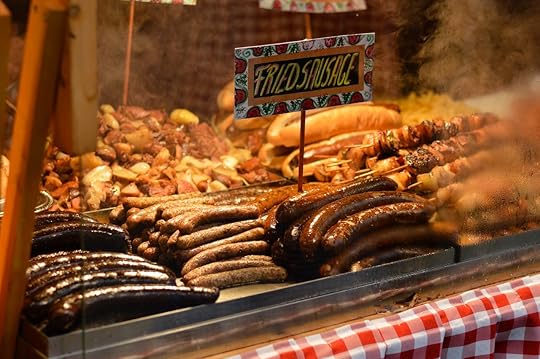
In his book, The Cuisine of Hungary, restaurateur and food writer George Lang writes that, “Somewhere along the line the Hungarians hit on the holy trinity of lard, onion, and pure ground paprika.” Kolbasz — the Hungarian word for sausage — might be considered an honorary fourth pillar in the pantheon of Hungarian cooking: It appears in stews, on appetizer platters, sliced on bread with a side of pickles and mustard, and at all meals of the day — including breakfast.
If paprika is one of the pillars of the holy trinity of Hungarian cuisine, then it holds special power in the realm of kolbasz. Almost every single variety of Hungarian sausage is seasoned with paprika, imbuing each with a deep red color and mildly spicy flavor. Paprika is the foundation of Hungarian sausage seasoning, and smoking, drying, and curing is the preferred cooking method (though you will find some kolbasz that are served fresh). But kolbasz are versatile, and you’ll find recipes that call for pan frying, grilling, and roasting sausages over an open fire.
Hungary is home to a thriving neighborhood market culture, where Hungarian people shop for groceries and traditional ingredients like sausage, salami, and other deli meats. Butchers stalls are commonplace in these markets, like the one in Budapest, called Kórház Utcai Market. These purveyors are where you can find the highest quality cuts of Hungarian sausage, from the classic kolbasz to hurka (offal sausage) and szalonna (fatback and pork belly).
Most Hungarian sausage is made from pork, and you’ll find all parts from the liver and lungs to the head and the heart deployed in various sausage varieties. Mangalitsa is the heritage breed of Hungarian pig, so you may want to specifically ask for Mangalitsa sausage or look for that label on the packaging.
These are 14 of the most popular types of Hungarian sausage you should know about before a trip to the country.
1. Lecso kolbasz
Photo: Whiteaster/Shutterstock
This sliced sausage is made specifically as an ingredient in a dish called lesco, a stew of onions, tomatoes, and banana peppers. True to Hungarian tastes, it’s heavily seasoned with paprika. Lecso usually incorporates sausage, but it’s also not uncommon to see it served with scrambled eggs.
2. Gyulai kolbászNamed for the city of Gulya, this smoked sausage is seasoned with paprika, pepper, caraway, garlic, and salt. A combination of pork meat and fat, the sausages are smoked over beech wood then hung up to dry and cure. Gyulai kolbász is almost always sold in pairs and is a common ingredient in Hungarian potato and egg casserole. This type of Hungarian sausage also enjoys PGI certification.
3. Budapesti téliszalámi
Photo: Lerner Vadim/Shutterstock
Covered in a white model casing that appears during the drying process (known as noble mold), this cylindrical smoked salami is flavored with allspice and white pepper. The name means winter salami, a reference to that fact it was once prepared in the colder months. In 2007, Budapesti téliszalámi received PGI status. Traditionally, winter salami is made only from Mangalitsa pork, a breed of Hungarian pig. Pick and Herz are the two most iconic salami producers in Hungary.
4. Csabai kolbászTypically produced in the town of Békéscsaba, Csabai kolbász is similar to Gyulai kolbász, but it’s much deeper red in color thanks to amount of paprika used to season it, and it’s also far spicier.
5. Veres hurka2h>
Photo: /Shutterstock
Hurka is a Hungarian offal sausage prepared using the liver and lungs of the pig, and sometimes pork snouts combined with rice and onions. Veres hurka adds blood to the mixture. Fresh blood sausage is often pan-fried or grilled and served with pickles on the side. Some Hungarian people say veres hurka is best paired with a cold beer. Another variety of hurka is majas hurka, which is made exclusively from the pig’s liver.
6. Hazi kolbaszThe name of this sausage translates to “homemade,” and perhaps fittingly the recipes vary depending on who is making it. Generally, hazi kolbasz is made from pork shoulder, and seasoned with cloves, lemon zest, cumin, cumin, and paprika.
7. Debrecener
Photo: Fanfo/Shutterstock
This orange pork or beef sausage is named after the city of Debrecen, where it originated. Seasoned with marjoram and paprika, which gives this sausage its rich color, Debrecener can be baked, broiled, or fried. You can find versions that are both smoked and unsmoked.
8. Cserkesz kolbaszThis long, thin sausage has the chewy texture of jerky, and like most other Hungarian sausages gets intense flavor from smoky paprika. It’s sometimes compared to a Slim Jim. Interestly, the term “cserkész” means boy scout in Hungarian.
9. Sonka
Photo: Morena Photo/Shutterstock
In Hungary, sonka refers to smoked ham. Sonka is traditionally served on Easter similar to many Easter traditions in North America. But sonka can also be sliced and eaten as an appetizer: One purveyor suggests eating sliced sonka with melon, a snack that might bring to mind Italian prosciutto and melon.
10. Szegedi szalámiAnother type of Hungarian salami that’s covered in noble mold. The city of Szeged has been making salami for around 140 years. The microclimate produced by the nearby Tisza river imparts this variety of salami with its distinct flavor. In 2007, szegedi szalámi received Protected Designation of Origin (PDO) status.
11. Szalonna
Photo: Szilard Csaki/Shutterstock
Similar to bacon, szalonna is fatback made from smoked and cured pork fat with the rind still attached. In Hungary, there are at least 20 different types of szalonna, but generally it’s sautéed, seasoned with paprika, and added to stews and soups. Another popular way to cook szalonna is to spit roast it over an open fire. Thinly sliced pieces of szalonna are also sometimes eaten on top of sliced bread with tomatoes. Csemege szalonna, for instance, is salted pork fatback with hardly any trace of meat while kolozsvári szalonna is salted and smoked pork belly.
12. DisznósajtDisznósajt technically means pork cheese, but it falls into the category of a head cheese, a type of terrine or meat jelly that combines different parts of the pig, including the head, tongue, heart, and ears. The gelatinous mixture is pressed into the pig’s stomach then dried and smoked. Disznósajt is a popular snack in Hungary served cold in rectangular slices.
13. SütőkolbászThis is one Hunagrian sausage that isn’t aged but served fresh. Sütőkolbász is baked or roasted in a frying pan and is then topped with mustard and served alongside sliced bread and pickles. Like the many varieties of kolbasz, it’s seasoned primarily with paprika.
14.VirsliThe roots of virsli, a variety of frankfurter, stretch back to Vienna. Hungarians made this style of smoked sausage their own, however, by serving them at breakfast or in a vegetable stew called főzelék. Virsli can be fried or boiled and are usually accompanied by a mustard dipping sauce. The most popular variety is called Bécsi virsli, made from beef and pork. 
The post 14 types of smoked and spicy Hungarian sausage you need to try appeared first on Matador Network.

YouTube pranksters make over $3,000 in bookings from dollhouse on Airbnb

YouTubers Josh Pieters and Archie Manners successfully pulled off a practical joke where they listed a fancy dollhouse on Airbnb and got real bookings. In a video posted on March 31, the duo revealed to the arriving guests that what they thought was an 18th century mansion was in fact, a dollhouse.
The Airbnb listing was priced at $120 per night. Pieters and Manners received over $3,000 in bookings while the listing was active. Their joke was documented in an eight-and-a-half-minute video showing the entire process, from taking high-resolution photos of the dollhouse to listing it on the booking platform to receiving notifications of bookings.

Photo: What’s My Place Worth,” which aims to help new hosts set their prices and start their business on the platform, in anticipation of a big travel demand this year. 
The post YouTube pranksters make over $3,000 in bookings from dollhouse on Airbnb appeared first on Matador Network.

April 22, 2021
Win a two-week ‘workation’ on a floating villa in Puerto Rico

If months of working from your home office has you desperate for a change of scenery, but a two-week vacation is not in the cards right now, Puerto Rico’s destination marketing team has you covered. The newly launched “Deskover Puerto Rico” contest is giving away six two-week “workations” for remote workers looking to trade in their stuffy living rooms for some fresh tropical air and warm Caribbean waters.
Applications are easy. To enter, visit the Discover Puerto Rico website by May 13 and submit a brief explanation of what the island-style work-life balance would mean to you. Roughly a week later, six lucky winners will be rewarded with round-trip economy airfare and 14 nights in a dreamy accommodation, from an apartment in historic San Juan to a suite at the Copamarina Beach Resort and Spa in Guánica to a floating villa off the coast of Fajardo.
For remote workers from the US, a “workation” in Puerto Rico is a no-brainer. You can leave your passport at home, and because the island is an American territory, US travelers need not worry about providing a negative COVID-19 upon reentry to the States. For more on what to expect while traveling in Puerto Rico, here’s a handy guide to everything you need to know about visiting, and to browse the official Deskover Puerto Rico contest rules, click here. 
The post Win a two-week ‘workation’ on a floating villa in Puerto Rico appeared first on Matador Network.

Escape to the country life in one of Airbnb’s most wish-listed barns

We hope you love the spaces and stays we recommend! Just so you know, Matador may collect a small commission from the links on this page if you decide to book a stay, and listed prices are accurate as of the time of publication.
Sometimes you need to step back to pivot away from hyper-modernism and appreciate how we got here. Sleeping in a barn is, by definition, a great way to do this. While the somewhat unique concept might sound a bit rough and ready, it’s far from it in these lovely redesigned properties that focus on comfort and seclusion, with a taste of life at a slower pace. Escape to rural life in one of Airbnb’s most wish-listed barns throughout the United States, Ireland, and the United Kingdom.
The barn guesthouse on Lookout Mountain — Rising Fawn, Georgia
Photo: Airbnb
Rural Georgia is the ideal spot to rent a barn, and while many barns call the Georgian forests and fields home, none have views like this one. With tall windows offering a glimpse into the surrounding trees but modern and lux trimmings in the living space and kitchen, this barn is somewhere between nostalgic and hipster — the best of both worlds. It’s perfect for couples to escape the city heat of Atlanta or Charlotte for a weekend retreat.
Two guests, one bedroom
Price: $149 per night

Photo: Airbnb
This white barn (not all have to be red) is among the oak trees of central California. If you’re wine touring Paso Robles, there’s no better spot to have a country-fueled dance party upon returning home after the tasting rooms close. This barn also offers easy access to everything from hiking to biking to beach lounging, and if you’re road-tripping along the Pacific Coast Highway, Atascadero is a perfect stop for a night or two to recharge mid-route.
Two guests, one bedroom
Price: $140 per night

Photo: Airbnb
When a UK-based celebration of love, family, and friends is in order, this large barn, a quick jaunt from downtown Haslemere, is just the spot. It’s ideal for weddings, with a special area for brides to prepare for the big moment. The host has put together a special package that includes hairdressers, photographers, and other necessities. The host also allows for late checkout on wedding days so that you can drive straight to the ceremony.
Seven guests, two bedrooms
Price: $175 per night

Photo: Airbnb
The English take on barns is equally rustic yet somehow more aesthetically pleasing than many on the west side of the Atlantic. Perched atop a small hill with expansive views of the Windrush Valley, this property is a Georgian barn turned modern getaway perfect for exploring the honey-colored stone of Cotswolds’ traditional villages.
Two guests, one bedroom
Price: $126 per night

Photo: Airbnb
Who knew a barn could be so thoroughly luxurious? This barn is just two hours from London, perfect for an overnight or extended escape and to bring a bit of romance into a trip to the big city. Miles of nearby forest trails wind through the lush forest, many of which involve a convenient finish at a traditional pub or tea room in the nearby village. Shopping, dining, and more pubs are a walk away from the barn itself.
Two guests, one bedroom
Price: $264 per night

Photo: Airbnb
It’s always surprising how much upstate New York feels like a world away from the big city — perhaps nowhere more so than this historic Barnhouse in Warwick. Within an hour’s drive from NYC, you’ll step back three centuries into a space that’s perfect for getaways with family and friends. A bbq and bonfire pit provide the entertainment, and with trails and lakes not far away, this is an ideal place to unwind for a weekend or longer in the semi-remote surrounds of Northeastern farm country.
Five guests, two bedrooms
Price: $199 per night

Photo: Airbnb
Adirondack chairs and fire pits go together like peas and carrots, especially in the mountains. Add an outdoor hot tub, and you’re in barndoor heaven in West Virginia, not too far of a commute from the big cities of the east coast. This barn also has fiber optic internet and a full kitchen, so you can be productive onsite while still taking advantage of the surrounding high-altitude amenities.
Six guests, three bedrooms
Price: $249 per night

Photo: Airbnb
On the shores of Lough Corrib, this 110-year-old stone barn is as traditionally Irish as it gets. The rental comes with bikes, which you can use to ride to the nearby pubs and check out the natural wonders of western Ireland. Head into the town of Clonbur for pub food and music, or simply stock up on nosh and kick it at the barn. It’s not often you get to experience “the old life” in such a way, and as a bonus, Connemara National Park and its legendary hiking trails are just a couple of hours away.
Five guests, one bedroom
Price: $138 per night

Photo: Airbnb
This barn is old, but the trimmings are new here in rural England. The host promises the barn to be perfect for “glorious isolation,” whether that leads you to reading, writing, working, or staring out the window at the beautiful countryside. Surrounding Ringwood are quaint lakes, hiking and biking trails, and plenty of opportunities to paddleboard or simply get lost in the forest for a while. 
Three guests, one bedroom
Price: $114 per night
The post Escape to the country life in one of Airbnb’s most wish-listed barns appeared first on Matador Network.

What is Australian cuisine? This chef thinks he has the answer.
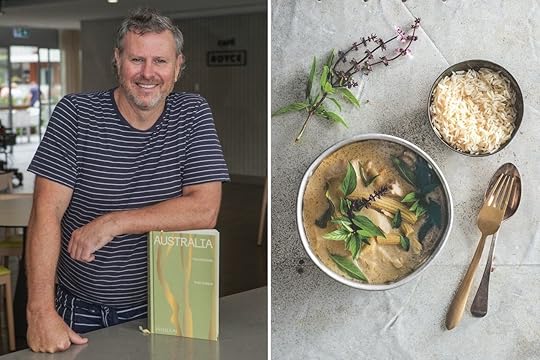
What is Australian cuisine? It’s a question that seems to prompt quizzical looks and vague answers. Is it defined by fresh and raw ingredients that reflect the island’s abundant produce? Does it come down to barbecued seafood, like shrimp? Or should Australian cuisine be defined as Aboriginal bushfood?
Ross Dobson, an Australian chef and food stylist, wants to answer that question once and for all in his book Australia: The Cookbook. His 431-page tome covers the incredible breadth of what Australian cuisine is now. It includes recipes for “mixed grill” — lamb chops and sausage grilled and sometimes served for breakfast, beer-battered fish, vanilla and lemon “slices” (similar to a tray-bake), to “bugs,” a crustacean native to Australian waters that are cooked in a cast-iron skillet.
However, Dobson’s perhaps more interesting and complex goal is to unravel how, exactly, Australian cooking has evolved since before European colonists came to the island. The book starts with a powerful note, which reads: “We acknowledge the Traditional Custodians of the Land, across the many language and cultural groups within Australia’s diverse Aboriginal and Torres Strait Islander communities, and we pay our respects to Elders past, present and emerging.” He starts his story by acknowledging that First Australians sustainably sourced seafood on the land now known as Australia for as many as 12,000 years and were very likely to be the first occupants to establish agriculture and aquaculture systems in the region.
It’s also worth pointing out that, in a subsequent section of the book, Dobson invites indigenous food educator Jody Orcher to write about how to respect and honor Aboriginal bushfood ingredients (which includes items like river mint, emu, raspberries, finger limes, and kangaroo), and their contributions to Australian cuisine.
Ocher writes that when Australian chefs use “bushfood that Aboriginal people have been using for generations,” they should recognize “where [these ingredients] come from, as cultural knowledge, preparation and cooking methods come directly from the traditional owners of country who have been sustaining these plants through Aboriginal land management practices for generations.” She also insists that if you’re going to use bushfood ingredients in your cooking, recognize how Aboriginal people used them (publicly, if possible) and make your best attempt to “demonstrate respect by asking traditional owner groups for permission to share knowledge, language and culture.”
From there, Dobson chronicles the history of immigration and migration that shaped Australia: In the 1700s, the British arrived to establish a penal colony, which was the start of a cultural and culinary influence that has lasted the rest of the country’s life span. English settlers adapted local recipes to accommodate traditions from home. They replaced Christmas goose with lamb, for instance, and seasoned crawfish and possum with curry powder — a spice mixed popularized in Australia thanks to England’s colonization of India.
One reason that Australian cuisine might not have been able to extricate itself from the shadow of British influence is simply that recipes from abroad were widely popular in Australia. Dobson writes that by the 1800s, “a good cake recipe published in Geelong, Victoria, for example, would more than likely go on to appear in print in Hobart, Adelaide or Perth.” He likens an English recipe spreading through Australia to a modern-day viral video.
The mid-19th century saw the next great wave of migration to Australia’s shores. Approximately 600,000 Chinese people immigrated to Victoria to search for gold, setting what Dobson calls the “blueprint” for modern Chinatowns in Australia. Hybrid Chinese-Australian food is a staple in the country today that can be seen in recipes like combination soup — a mix of barbecue pork, prawns or shrimp, Chinese greens, and both egg noodles and wontons — and Peking duck pancakes.
For the rest of the country’s history continuing through today, every aspect of how Australian cuisine has developed has been marked by immigration. Greek immigrants introduced the Australian concept of the milk bar, where the iconic “hamburger with the lot” (a hamburger topped with a fried egg and beets) can be found. A wave of European immigrants introduced once skeptical Australians to ingredients like garlic, olive oil, and Parmesan cheese. According to Dobson, this prompted a craze for Italian food that Australians can still feel today in recipes like one for a marinara sauce that includes slipper lobsters and mussels.
However, the most significant impact on Australian cuisine might come from the nearly 80,000 Vietnamese refugees who arrived on the island following the Vietnam War. Dobson says that “Australians cannot get enough of the fresh and fragrant offerings of Vietnamese food.” And that pho, in particular, seems to have tapped into some deeply rooted desire in the Australian palate. It’s a national dish of Vietnam, but also arguably of Australia. Many Australians are drawn to the freshness and vegetable-forward dishes of Southeast Asian cuisine, embracing both Indonesian and Thai food.
This history of adaptation and hybridization creates a cuisine that’s difficult to pin down or define in simple terms. The country is inherently multicultural, and the food reflects the amalgamation of flavors and cuisines that the island has absorbed over the years. As Dobson puts it, Australian cuisine is “an eclectic combination of ingredients and cooking styles.”
One especially fundamental aspect of Australian cuisine is the ability of professional chefs and home cooks alike to rework a classic dish from another culture — a Thai green papaya salad served with barbecue fish, for example. It’s a cooking philosophy that amounts to “bit from here, a bit from there.”
These are the five dishes that define Australian cuisine, according to Dobson.
1. Finger Buns
Photo: Alan Benson
Australian finger buns are bite-sized pastries split open, “slathered in butter,” and topped with frosting for a touch of sweetness. They’re usually pink and sprinkled with coconut.
“These are the comeback kid of Australian baking,” Dobson says. “Popular in the 1970s and 80s, they are back in vogue with many artisan bakeries resurrecting them. They are gorgeous things to look at and melt in your mouth.”
2. Som tum


Photo: 271 EAK MOTO/Shutterstock
Australian people fell in love with Thai food in the 1980s. This prawn and papaya salad is full of freshness, with a tart kick from tamarind and lime juice and spice from bird’s eye chilies. In keeping with Australian seafood traditions, fresh produce is combined with prawns.
“This green papaya salad has a kick,” Dobson says. “There was a time when you would have been hard-pressed to find this dish in Thai restaurants. But as the average Aussie palate craves more authentic [Thai] dishes, this is creeping its way onto many suburban Thai restaurants.”
3. Beef pho
Photo: Alan Benson
In the early 1970s, Vietnamese flavors caught fire in Australia. Today, pho is considered one of the most popular dishes in the country, especially in big cities like Sydney and Melbourne.
“Similar to som tum, this soup (probably the national soup of Vietnam) can now be enjoyed in many places in Australia, and is no longer limited to inner-city suburbs of Melbourne and Sydney,” Dobson says. “Australians have taken to Vietnamese food in a big way as we crave the freshness.”
4. Salt and pepper squid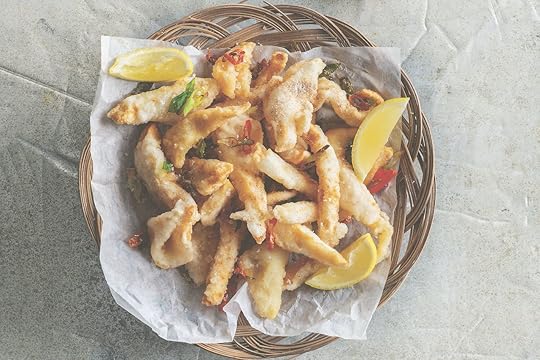
Photo: Alan Benson
Dobson gives credit for this dish to the creation of hybrid dishes, which combines the Australian taste for seafood with Cantonese flavors.
“It would not be hyperbole to say that this one appears on almost every pub menu, right next to chicken parmi,” Dobson says.
5. Thai green chicken curry
Photo: Alan Benson
“I’ve eaten this in many other countries outside of Thailand,” Dobson says. “But Australian versions are as close to authentic as you can get. I guess it is because the fresh ingredients used in Thai recipes are grown in Australia. And this dish is unique in other ways. Thai green curry is one of the most popular dishes to order as a takeaway or home delivery, and it is one of the most searched for recipes on Australia’s top food sites for people to make at home.” 
The post What is Australian cuisine? This chef thinks he has the answer. appeared first on Matador Network.

The best itinerary for a magical and eco-friendly vacation in Belize

Though it’s the smallest country in Central America, Belize’s unique terrain and tropical climate mean that it has just as much to offer as its more expansive neighbors. The Meso-American Reef — the second-longest coral reef in the world after Australia’s Great Barrier Reef — runs the entirety of Belize’s 240-mile-long coastline, and it only takes a few minutes of driving away from Belize City before dense, verdant jungle replaces the coastal views.
And as you’d expect, Belize’s combination of ocean life and lush landscapes attracts travelers with a sense of adventure (and a willingness to sweat a little.) Belize’s healthy reserves, jungle, and natural sites are the main draw for most tourists, which is why it’s essential to protect the country’s natural resources. Since the country’s tourism relies on a healthy environment, and many locals rely on tourism, planning an eco-friendly trip to Belize is key to ensuring both wildlife and small communities can thrive.
For the perfect sustainable trip to Belize, read on to learn about the best places to stay, trips to take, and places to explore to make sure you’re keeping the country’s wildlife and wild spaces healthy as can be.
Day one: Live the island life on Caye Caulker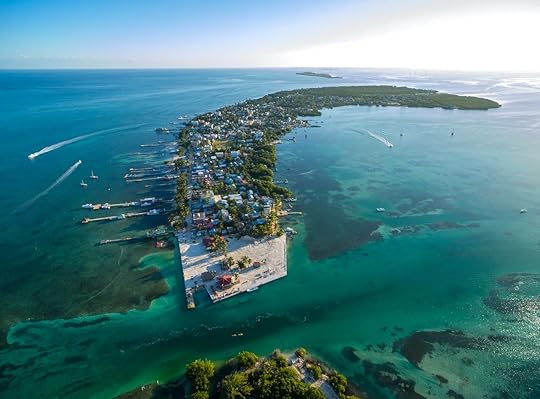
Photo: photosounds/Shutterstock
Most travelers seeking a beach escape head to Ambergris Caye, but if you’re trying to plan a sustainable trip to Belize, head instead to Caye Caulker. It’s just a 45-minute water taxi from Belize City, and since the island is free of cars, you’ll be doing your part to keep your carbon footprint down while you’re there. You can walk everywhere, every bar and restaurant is open-air, and shoes are decidedly optional.
If you’re into diving, you’ll appreciate that Caye Caulker is actually closer to the Great Blue Hole, one of the world’s most famous diving and snorkeling sites, than Ambergris Caye. Traveling with a small scuba dive shop in Caye Caulker is a great way to support small businesses and fight over-tourism in Ambergris Caye, and ensure you reach the Great Blue Hole before the tourist boats from Ambergris. Consider diving with locally owned and PADI-certified Frenchies Dive Shop.
If you’re not diving, spend your time at the Split. It’s the best beach on the island and is home to a few beach bars and places where you can rent beach chairs or snorkel gear. Be sure to wear reef-safe sunscreen on the island.
Day two: Make friends at the Community Baboon Sanctuary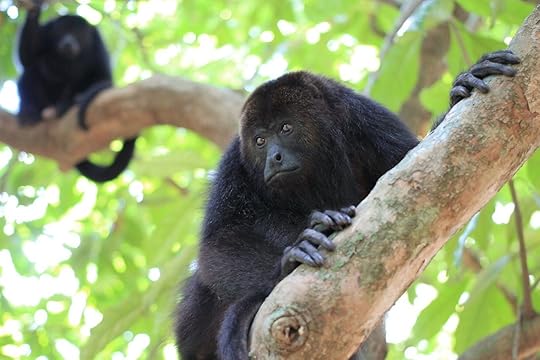
Photo: Randy Bjorklund/Facebook
While you’re likely to see (or at least hear) howler monkeys if you venture into Belize’s jungle, if you want the best chance of seeing monkeys, do it in a place safe and cage-free environment: the Community Baboon Sanctuary. Black howler monkeys (which locals call baboons) are endangered due to deforestation and the encroachment of grazing and agricultural land, so in 1985, two concerned primatologists opened the sanctuary.
As if protecting howler monkeys wasn’t enough, the sanctuary is staffed entirely by women from local villages, providing them with employment and education while also saving wildlife. The center is small, but visits include access to the museum and a guided walk through the reserve. While howler monkey encounters aren’t guaranteed, they are likely, and the howlers are usually happy to come close to grab a fresh green leaf from your hand. As of 2019, the sanctuary protected more than 2,000 individuals across its 20-square-mile area.
Day three: Head into the jungle at Black Rock Lodge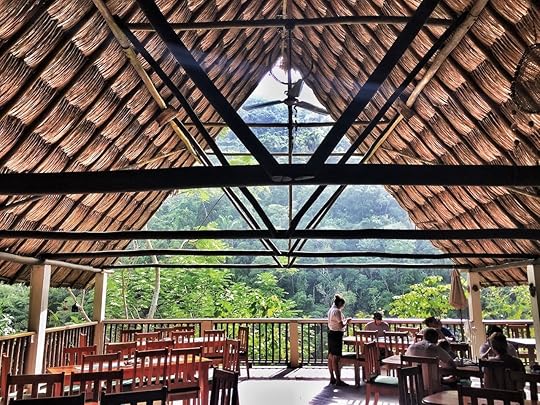
Photo: Suzie Dundas
Many of Belize’s best hotels are deep into the jungle, and none capture the beauty of that landscape better than Black Rock Lodge, an off-the-grid eco-lodge on the Macal River. In fact, you’ll get a free beer in the restaurant if you manage to make it over the resort’s small waterfall without flipping your river tube.
Whether you book a low-key cabin or one of the more luxurious suites, it’s one of the best places to stay for a sustainable Belize vacation. The lodge backs to the Mountain Pine Ridge Forest Reserve, so hiking and birding are always on the agenda. It’s carbon neutral and has its own organic garden, waste-water treatment plant, and solar and hydropower systems. It’s actually reforesting its 20-acre site that was once cleared for livestock grazing. It offers free sustainability tours as well as night hikes to help you spot nocturnal creatures like tree frogs and — if you’re lucky — even jaguars. The thatched-roof restaurants and reception area is one of the most beautiful buildings you’ll see in the country.
Day four: Explore the ruins of a Mayan metropolis
Photo: Milonk/Shutterstock
Pronounced “Zhu-nahn-tu-nich,” the Xunantunich ruins were once an enormous Mayan city — one of the largest ever built, in fact. The area currently available to visit is about one square mile, but archaeologists are confident there’s more in the area to uncover and will likely be working here for decades to come. The site is home to a small museum worth visiting first to gain background knowledge on the site and Mayan culture as information near the actual ruins is minimal.
You have a few ways of visiting Xunantunich. You can certainly go alone if you have a car; the site is open from 9:00 AM to 5:00 PM most days. If you’re lucky, you may even find a docent or on-site volunteer willing to spend some time chatting with you and sharing their knowledge and enthusiasm. If you don’t have a car or prefer a guaranteed tour guide, book a tour of Xunantunich with a locally owned guiding company to help some of the country’s more remote economies. Good choices include PaczTours, UnTame Belize, or Get to Know Belize.
Day five: Adventure through the Mayan underworld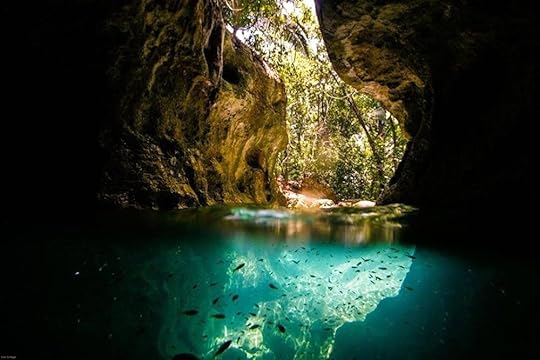
Photo: Pacz Tours
Belize — along with Guatemala and Honduras — was the geographic and cultural center of the Maya, who flourished from around 2000 BCE. to around 1500 CE (depending on your source). If you’ve already toured a Mayan city, spend the next day learning about Mayan culture — and you’ll need to go deep into the heart of the Mayan underworld to do so.
Fortunately, the Mayan underworld is relatively accessible, provided you don’t mind a bit of swimming and dark spaces. The Maya thought Actun Tunichil Muknal Cave (ATM Cave for short) was the gateway to the underworld, linking the surface level with spirits and gods deeper in the earth. It was a sacrificial site, which you’ll see for yourself if you make it to the end.
If you’re planning a sustainable trip to Belize, ATM Cave is one of the best to visit as access to the cave is highly controlled. To protect its cultural and environmental value, the government permits only a small number of guests to visit per day, escorted by an approved tour guide. What you can carry in is very limited — no cameras, sunscreen, backpacks, or anything else that could otherwise cause damage — and you’ll need to wear clothing over your swimsuit in respect of the cave’s religious importance for Mayan descendants.
Tours of the cave last around three hours, and your guiding company will provide life vests, headlamps and helmets, and knowledge on the history and technology of the cave. It doesn’t require extreme physical fitness, but you should be comfortable swimming, hiking, and doing some light spelunking.
Day six: Hit the beach at Hamanasi Resort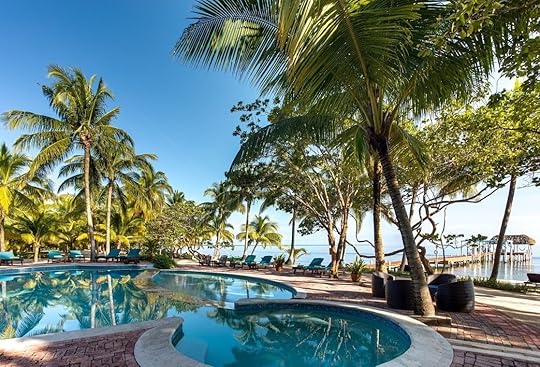
Photo: Hamanasi Resort/Facebook
Once you’re done exploring the jungle (as if that would ever be possible,) head south to the beaches of the Placencia Peninsula, a 16-mile-long strip of small communities and coastline ending in the low-key resort town of Placencia. A great place to stay is Hamanasi Resort, about 30 minutes north of the peninsula in the town of Hopkins, which has an admirable list of initiatives to support sustainable communities and clean beaches. The resort buys all its amenities and food locally; grows its own fruits and vegetables; propagates its own seeds; has no single-use products; and makes the most of its furniture in its on-site carpentry shop. It even has a large part of the property reserved just for wildlife — don’t expect a hotel expansion anytime soon.
Snorkeling is always an option at this beachfront resort, but certified scuba divers may want to consider taking part in a lionfish spearfishing adventure. Though it may sound counterintuitive, removing lionfish is paramount to reef health. Lionfish are a highly invasive species with no natural predators, so high populations lead to a loss of biodiversity, which eventually kills the reefs. You can learn to prepare your catch for lunch when you finish your dive. You may also be able to safely snorkel with whale sharks if you’re in the area between March and June.
Day seven: Stretch your legs at the Cockscomb Basin Wildlife Sanctuary & Jaguar Preserve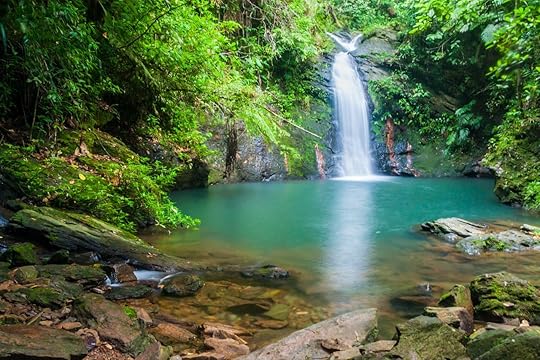
Photo: Matyas Rehak/Shutterstock
For the final day of your sustainable trip to Belize, pack your waterproof hiking sandals and head to the world’s only jaguar preserve. The reserve is 250,000 square acres and is home to approximately 200 jaguars, though you’re unlikely to see one during your visit — they’re very stealthy creatures. However, while taking one of the park’s hiking routes, you may see their footprints, called pugmarks. Truthfully, it’s far more likely that they’ll see you rather than the other way around.
The sanctuary has several hiking trails, various swimming areas, a small visitor center, and several waterfalls. It also rents tubes and offers tours and presentations on the park’s flora and fauna, which include more than 300 bird species as well as small mammals like jaguarundi and coatimundi, peccaries (akin to wild pigs), howler monkeys, and adorable rodents like gibnuts and agouti. You can take a taxi from Dangriga to reach the reserve, though most guests find it easier to book a tour through their hotels, which usually include lunch, too. 
The post The best itinerary for a magical and eco-friendly vacation in Belize appeared first on Matador Network.

Surfer reunited with lost surfboard

The world’s oceans are incredibly vast, so the chances of retrieving something lost in their waters are next to nil. That’s why the story of Danny Griffiths, an Australian surfer, is so surprising.
Four years ago, Griffiths was surfing at Pedra Branca, a famous big wave break off the south coast of Tasmania, when he wiped out. When a jet ski picked him up, they looked for Griffiths’ beloved customized surfboard, but it was nowhere to be found.
But recently, a group of surfers ran into an older couple who happened to tell the story of their sons finding a surfboard while they were fishing in Queensland, Australia, about 1,670 miles away from where it was lost, according to BBC. After the surfers saw a few photos from the brothers, they confirmed that the surfboard belonged to Griffith.

Photo: Danny Griffiths
Scientists have marveled at the chance finding because the surfboard had floated in the opposite direction of the current. They plan to run further testing on the board to figure out how it made the journey there.
After some reluctance, the brothers agreed to return the board to Griffiths, who said that while the board had a few cosmetic injuries, it was “100 percent surfable.” Now that Griffiths and his board are reunited, he plans to return to Pedra Branca and try that wave again. 
The post Beloved surfboard lost at sea reunited with owner four years later appeared first on Matador Network.

Best beaches in New England to party

Summer has the ability to conjure a specific scene in the imagination: an endless beach touched by a gentle tide, with all your friends circled up on the sand playing music from a spotty bluetooth speaker, drinking hard seltzers in broad daylight even though they’re probably illegal to consume on said beach.
Most Americans don’t live anywhere near a beach, yet the fantasy is still the same for many. For the landlocked, the solution is usually jetting off to California, Mexico, Florida, or a Caribbean island for a dose of sun and sand. This summer, add New England to that list. The region is more than just historic homes, aggressive drivers, and Patriots bumper stickers. New England has some of the country’s best beaches — not just for quiet relaxation but also good old-fashioned summer shenanigans.
From Maine to Rhode Island, these are the New England beaches (including ocean, river, and lake beaches) that you should party at this summer.
1. Salisbury Beach, Massachusetts
Photo: Surfside Salisbury Beach/Facebook
“Going to Salisbury Beach” means more than just posting up on the sand. You could spend a whole day here without ever setting foot on the beach itself. Located on the northernmost tip of the Massachusetts North Shore, which is within sight of New Hampshire, Salisbury Beach is known for two things: how easy it is to get away with drinking on the beach (which, to be clear, is not technically allowed) and the bars along its historic midway.
Just steps from the beach, bars like Surfside have unparalleled views of the water and live music every weekend in the summer. Make sure to stick around for Reggae Sunday, when Surfside hosts a reggae band, and the beach community really comes alive. You’ll also stumble across one of the pizza world’s most bitter rivalries.
Beach pizza is a pizza style unique to the Salisbury Beach area that’s defined by its rectangular shape, sweet sauce, and sparse use of cheese. Tripoli’s and Cristy’s have been rivals for decades, and each spot has its own fiercely loyal following. Deciding which one to patronize might be your most important decision of the entire trip.
2. Hampton Beach, New Hampshire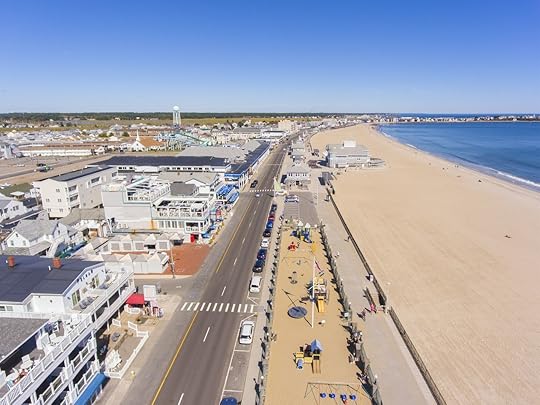
Photo: Wangkun Jia/Shutterstock
Hampton Beach takes the best of Cape Cod and Las Vegas and rolls it all into one walkable strip. The mile-long beach itself has been named one of the cleanest in the country, though you might not know it by witnessing the debaucherous scene across the street. Running parallel to the beach, the Hampton strip is full of bars, restaurants, live music venues, and two casinos, attracting hundreds of partygoers every weekend in the summer.
Bernie’s Beach Bar is one of Hampton Beach’s most popular venues. Right across from the Beach, Bernie’s is an entirely outdoor restaurant and bar with a second-floor deck overlooking the ocean, and it hosts live music every weekend. There’s also Wally’s Pub, L Street Tavern, and several other bars just steps from the beach. The strip’s most widely known venue, however, is probably the Casino Ballroom. This full-fledged concert venue hosts both local acts and internationally recognized talent, like Third Eye Blind and Matisyahu. As for the casinos themselves, there’s the Hampton Beach Casino and Aces and Eights. Both offer low-minimum play, making it much harder to drunkenly bankrupt yourself.
3. Narragansett Town Beach, Rhode Island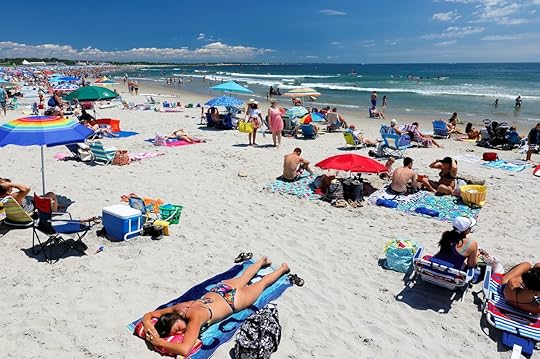
Photo: Jay Yuan/Shutterstock
One of the most popular beaches in New England, Narragansett is also often considered the best for surfing. With a designated surf area, you can either hop on a board yourself or just sit back and watch the wipeouts. The 19 acres of beach are located right next to the center of town, putting beachgoers within easy walking distance of restaurants and bars.
The historic Coast Guard House is the closest you’ll get to dining right on the water. The restaurant is known for its deck right over right rocks, as well as its selection of seafood and cocktails. PJs Pub is another local favorite, located just three blocks from the beach, and Crazy Burger is a BYOB burger bar right around the corner.
For a change of scenery, you can also take the ferry to Block Island. After just an hour’s voyage, you’ll arrive at the New England version of island paradise, with plenty of nature trails and unspoiled beaches to explore.
4. Old Orchard Beach, Maine
Photo: Jay Yuan/Shutterstock
Old Orchard Beach is exactly what someone who has never been to New England pictures when they think of New England. Home to one of the last remaining oceanfront amusement parks in the US, the beach has a historic pier complete with a classic carousel, rides, and carnival food. The pier itself extends 500 feet into the ocean, featuring several family-friendly seafood restaurants during the day, and nightlife and live music at night. With frequent musical performances, drink specials, and bars, the Pier has one of the most popular bar scenes in Southern Maine. If that’s not enough for you, there are also fireworks shows every Thursday night in the summer. To truly relive your youth, the Palace Playland has over 25 rides and attractions for all ages, including one of the top five roller coasters in the country — the Galaxi Coaster.
5. Cahoon Hollow Beach, Massachusetts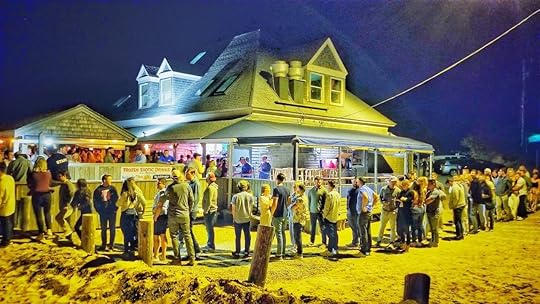
Photo: Wellfleet Beachcomber/Facebook
Going to Cape Cod is like waiting in one of those Chick-fil-A lines that stretch across four lanes of traffic. The journey is miserable, but once you arrive, it’s all worth it. Cahoon Hollow Beach in Wellfleet is totally worth the gridlocked drive over the Sagamore Bridge. The beach is mainly known as the “Beachcomber” beach — a name derived from the Beachcomber, one of Cape Cod’s most popular bars for live music and cocktails. As such, the beach attracts crowds from all over the Cape eager to enjoy the waves, dunes, and seaside party scene.
Frequently voted one of the best beach bars in the country, the Beachcomber has a long history dating back to 1953 when it served as a small inn of the same name. It was sold to its current owners in 1978 and has been one of the Cape’s most iconic bars ever since. Nestled in the dunes of Cahoon Hollow Beach, the bar has sweeping views of the ocean and calls itself “Cape Cod’s only restaurant and club.” So while Cahoon Hollow Beach might not have as much variety as Old Orchard in Maine, its star attraction is certainly worth a few hours in traffic.
6. Weston’s Beach, Maine
Photo: Joe Massimino/Shutterstock
Movies might suggest that a classic New England summer is spent on Nantucket, wearing Sperrys and playing Can Jam on the beach. Anyone from New England will tell you it’s actually camping by the Saco River in Maine. The river itself spans 136 miles from the White Mountains to the Atlantic Ocean and has become synonymous with long summer weekends. There are seemingly endless locations along the riverbank to set up camp and go tubing with beer in hand, but Weston’s Beach in Fryeburg is undoubtedly one of the best. Combining the river and beach experience, Weston’s Beach is a much smaller beach than you’re probably used to, but it’s the perfect spot to set up some chairs, pop a cooler, and watch your friends drunkenly try to navigate the river in their tube. The area is also great for swimming and kayaking.
7. Weirs Beach, New Hampshire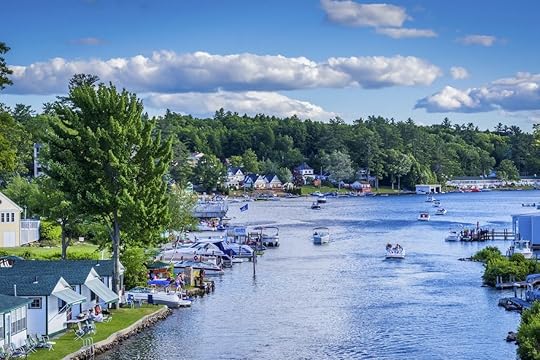
Photo: Jon Bilous/Shutterstock
Lakes in New England are like the ocean’s less appreciated younger brother. They never quite get as much attention. If there’s one lake that occasionally gets the praise it deserves, it’s Lake Winnipesaukee in New Hampshire. The state’s largest lake, Winnipesaukee is located at the foothills of the White Mountains and is one of the region’s most popular summer vacation destinations. Weir’s Beach in Laconia is the best place to take advantage of all the scenery and other attractions the lake has to offer.
The beach itself, located on the southern shore of the lake, is in the heart of all the action. The boardwalk and pier have several shops, restaurants, boat rentals, and arcades. There’s even the Weirs Beach drive-in theater. Just a few miles away you’ll find the Gunstock Mountain Adventure Park with the region’s largest ropes course, and Funspot, the largest arcade in the world. Also make sure to hit up the Bank of NH Pavilion, which hosts huge live concerts every few days in the summer. The biggest weekend around Weirs Beach is probably Laconia Motorcycle Week in mid-June, when thousands of motorcycle enthusiasts descend on the small town. Yes, it’s exactly as rowdy as you’re imagining. 
The post The 7 best New England beaches to blow off some steam this summer appeared first on Matador Network.

The world’s biggest cruise ship will debut in China next year

Royal Caribbean International is planning to debut the world’s biggest cruise ship in China. The Wonder of the Seas cruise ship will set sail from Shanghai in March of 2022.
According to a press release, passengers on the super-sized ship can expect to sail from Shanghai to Japan with stops in Osaka, Fukuoka, Kobe, Tokyo, and more between March and November 2022. From November 2022 to January 2023, the ship will port in Hong Kong and sail to such destinations as Chan May, Vietnam; Busan and Jeju, South Korea; Kochi and Okinawa, Japan; and Taipei, Taiwan for the holiday season.

Photo: Royal Caribbean
“China continues to be one of the most important parts of the world for Royal Caribbean. We have won the trust of our partners and the favor of travelers and built on that significantly since we first set sail 12 years ago. By introducing Wonder of the Seas and the iconic Oasis Class to China, our strong commitment to the market’s growth is reaffirmed yet again for years to come,” said Michael Bayley, president and CEO of Royal Caribbean International.
The massive cruise ship will be able to host almost 6,988 guests in 2,867 staterooms with packages between four to nine nights already available for booking. Guests will enjoy 18 decks and the ship itself will be divided into eight neighborhoods, each with different amenities: Central Park, Boardwalk, Pool & Sports Zone, Entertainment Place, Royal Promenade, Vitality Spa & Fitness Center, Youth Zone, and Suite Neighborhood. Stand-out features include the high-diving acrobatic and aquatic performances, the tallest slide at sea, and an 80-foot zip line. 
The post The world’s biggest cruise ship will debut in China next year appeared first on Matador Network.

The US sets ambitious, “game changing” greenhouse gas emissions target for 2030

At a climate summit this week, the United States just committed to cutting its greenhouse gas emissions in half by 2030. The Biden administration is hoping the goal will encourage other countries to do likewise in the collective effort to fight global warming. Specifically, the US’ goal is to cut emissions by 50 to 52 percent from 2005 levels by 2030 — a goal British Prime Minister Boris Johnson called “game changing.”
Other countries made similar pledges, with Japan’s PM Yoshihide Suga aiming to cut emissions to 46 percent by 2030, and Canada’s PM Justin Trudeau announcing plans to cut emissions by 40 to 45 percent by 2030.
The US emissions goal is expected to be reached through cuts to power plants, automobiles, and other industries. Specific details of these cuts haven’t been released yet, but Biden’s proposed $2.3 trillion infrastructure plan could help reach this greenhouse gas emission goal. It establishes a clean energy standard to achieve net zero emissions in the power sector by 2035, and a plan to transition to electric vehicles, Reuters reported.
The new emissions goal is part of a broader campaign to completely decarbonize the US economy by 2050. 
The post The US sets ambitious, “game changing” greenhouse gas emissions target for 2030 appeared first on Matador Network.

Matador Network's Blog
- Matador Network's profile
- 6 followers



